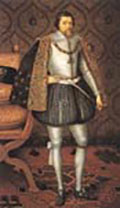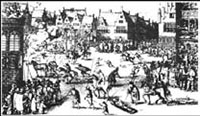Past Talks
The Gunpowder Plot of the Midlands
Date: 20th October 2008
Speaker: Mary MacDonald
The Meeting was held at St Edburg’s Church Hall, Bicester. Forty two members were present and one guest. Bob Hessian introduced the speaker, Mary MacDonald.
Mary set her account in the time of religious persecution of Roman Catholics at the turn of the C17th. England had experienced religious tumult in the century before James I became King. The Protestant establishment were suspicious of Catholic intentions. Early in his reign James I had indicated that there would be religious freedom for Catholics but Protestant pressure saw him reverse this policy. Many younger Catholics were angered by this.





Robert Catesby was the leader of the plot. He was hot headed but charismatic. In 1604 he gathered together a small band of conspirators including Guy Fawkes, a mining expert. Thomas Percy, one of the conspirators, was appointed to the Royal Guard. He therefore had a legitimate reason for being at Court and being able to move freely. He was able to rent a house in the royal precincts. The detailed planning for the plot was finalised over the summer months. Problems were encountered in digging a tunnel from the house to Westminster Hall where Parliament would meet. Parliament was not called in 1604 and there was be a ten month wait until it convened in 1605.
The delay enabled the plotters more time to organise themselves. A store house became available next to Thomas Percy’s house. Gunpowder was brought there and hidden under piles of faggots. Rumours of a plot were rife in Catholic circles. It seems unlikely that the authorities were not aware of the rumours. They appear to bide their time and let the situation develop. They probably knew who the conspirators were. The gathering of Parliament was delayed from July 1605 to November of that year. The plotters continued with their scheme particularly planning for the aftermath of their actions. They planned to abduct the Princess Elizabeth from Coombe Abbey and when the King was dead, place her on the throne with Catholic advisers who would influence her to return the country to the Catholic religion.
The conspirators were getting desperate due to the delay. The gunpowder had to be replaced. Were the authorities getting suspicious? A search of the store house by the authorities failed to spot the explosives. Was this deliberate to encourage the conspirators to carry on with the plot? Arrests of a wider circle of plotters could be made when additional conspirators were revealed. The plotters were running short of money to finance their plans as religious fines had to be paid.
The story of the failure of the plot is well known. A warning letter to Lord Monteagle from the conspirators was presented to the King. Guy Fawkes was arrested and tortured. The plotters took flight and were arrested to face charges for treason. Those arrested were subsequently executed by being hung, drawn and quartered although a number, including Catesby, were killed resisting arrest.
A number of elements are not so well understood. The fate of those connected to the conspirators, such as their wives and children, were questioned but later released without charge. The servants were all willing to distance themselves from the actions of their lords and masters. The future treatment of Catholics following the plot was interesting to note. It was to the authorities’ credit that there weren’t mass reprisals that could have led to a blood bath of persecution. When King James died and his son Charles I took the throne, the role of the Catholics in the English Civil War proved beneficial to the monarchy.
Mary answered questions following her talk. The Meeting closed at 8:47 pm.
